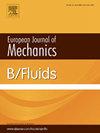Reconfiguration and drag reduction of flexible beam with point buoyancy in oscillatory flow
IF 2.5
3区 工程技术
Q2 MECHANICS
引用次数: 0
Abstract
Flexible structures with point buoyancy widely exist in nature and engineering. Under the action of oscillating flow, it usually has a large geometric nonlinear dynamic response. However, the dynamic response and drag reduction of flexible structures with point buoyancy have not been studied. Therefore, the numerical method in this paper investigates the dynamic response and drag reduction of point buoyant flexible structures under oscillatory flow. Firstly, complex spatial curvilinear coordinates establish the dynamic partial differential equations of flexible structures with point buoyancy. Then, the implicit finite-difference time-domain method is used to discretize the partial differential equation in space and time to form an algebraic equation. Finally, the dynamic response and drag reduction of flexible structures under non-buoyancy, uniform buoyancy, and point buoyancy are numerically analyzed. The results show that with the increase of Cauchy number CY, the deformation of the flexible structure becomes larger and larger, and a local bending point appears. The dimensionless vibration frequency numbers explain the occurrence of local bending points. Unlike no buoyancy, uniform buoyancy and point buoyancy make the flexible structure smaller and more symmetrical. Uniform buoyancy and point buoyancy can increase the Reconfiguration number R. The greater the buoyancy and buoyancy position, the greater the Reconfiguration number R. The load on the flexible structure under oscillating flow is still less than that on the rigid structure. The Vogel exponent is calculated by fitting the Reconfiguration number R. The drag reduction is directly proportional to the Vogel exponent v, that is, the greater the Vogel exponent v, the greater the drag reduction. When the Cauchy number CY is large, the Vogel exponent v of uniform buoyancy and point buoyancy is smaller than that of non-buoyancy. The greater the point buoyancy and buoyancy position, the smaller the deformation of the flexible structure, the greater the Reconfiguration number R, and the greater the Vogel exponent v. When the buoyancy position is small, the influence of point buoyancy on the flexible structure can be ignored.
振荡流中带点浮力柔性梁的重构与减阻
点浮力柔性结构在自然界和工程中广泛存在。在振荡流的作用下,通常会产生较大的几何非线性动力响应。然而,对于具有点浮力的柔性结构的动力响应和减阻问题,目前还没有研究。因此,本文采用数值方法研究了点浮力柔性结构在振荡流作用下的动力响应和减阻问题。首先,利用复杂空间曲线坐标建立了具有点浮力的柔性结构的动力偏微分方程;然后,利用隐式时域有限差分法对偏微分方程在空间和时间上进行离散,形成代数方程。最后,对柔性结构在无浮力、均匀浮力和点浮力下的动力响应和减阻进行了数值分析。结果表明:随着柯西数CY的增加,柔性结构的变形越来越大,并出现局部弯曲点;无量纲振动频率数解释了局部弯曲点的发生。与无浮力不同,均匀浮力和点浮力使柔性结构更小、更对称。均匀浮力和点浮力均可使重构数r增大,浮力和浮力位置越大,重构数r越大,振荡流作用下柔性结构所受载荷仍小于刚性结构。通过拟合Reconfiguration数r来计算Vogel指数。减阻量与Vogel指数v成正比,即Vogel指数v越大,减阻量越大。当柯西数CY较大时,均匀浮力和点浮力的Vogel指数v小于无浮力的Vogel指数v。点浮力和浮力位置越大,柔性结构的变形越小,重构数R越大,Vogel指数v也越大。当浮力位置较小时,点浮力对柔性结构的影响可以忽略。
本文章由计算机程序翻译,如有差异,请以英文原文为准。
求助全文
约1分钟内获得全文
求助全文
来源期刊
CiteScore
5.90
自引率
3.80%
发文量
127
审稿时长
58 days
期刊介绍:
The European Journal of Mechanics - B/Fluids publishes papers in all fields of fluid mechanics. Although investigations in well-established areas are within the scope of the journal, recent developments and innovative ideas are particularly welcome. Theoretical, computational and experimental papers are equally welcome. Mathematical methods, be they deterministic or stochastic, analytical or numerical, will be accepted provided they serve to clarify some identifiable problems in fluid mechanics, and provided the significance of results is explained. Similarly, experimental papers must add physical insight in to the understanding of fluid mechanics.

 求助内容:
求助内容: 应助结果提醒方式:
应助结果提醒方式:


